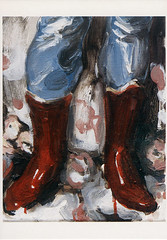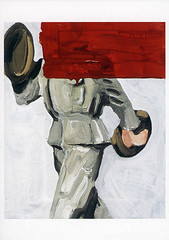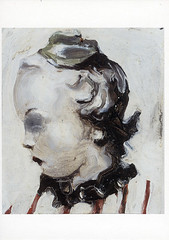crox 17, copy art project NR 5 (1991).
crox 33, solo project (1995). Drawings.
crox 51, Open Doors [Open Deuren] (a neighbourhood project) (1996). Paintings. Presented in a garage. This is the first time he shows just
paintings.
Joins the crox team in 1996. From the end of 1996 till July 2000
croxhapox' artistic path is set out by the crox team. The other members are
Kristel De Buck, van, Guido De Bruyn and Sjoerd Paridaen.
crox 70, Schilderkunst Hedendaags Belgisch [Painting Contemporary
Belgian] (1997).
Starts a band with van and Merlyn Paridaen, "The Singing Painters" (early 1998).
crox 81, mailart instalraam [installation window] (1998). The
continuously changing display (after Art Machine (crox 1) probably the most
informal project of croxhapox) includes some parts of a mailart correspondence
between Michaël Borremans and van.
Leaves the crox team in 1998.
Publication of two crox cards, Nrs. 7 and 8. Later also 19, all of them sold out by
now.



left to right: Dog (1998), Pixie (1998) and Terror Identified (Love Unlimited): Web (1998)
crox 93, solo project (1999). Second solo project. Paintings.
Critique by Edith Doove.
crox 104, the first 10 (2000).
crox 110, BASICS 1 (2003). Drawings.
crox 145-I, BASICS 2 (2005). A maquette.
Apart from drawings and paintings, MB starts to make films.
Enters the board again in early 2006.
crox 145-II, sequel BASICS 2 (Oudenaarde) - April 2006.
crox 188, BRAINBOX unit 4 (2006). Trio with Tinka Pittoors and Dirk Zoete.
Anarchistic plowing.
crox 446, BRAINBOX3 unit 1 (2013). With Miet Warlop and Hannelore Van Dijck.
At the end of 1984 Michaël uses the first floor of Beverhoutplein 7 as a
workplace. Thanks to Michaël, van arrives in the same building from end March
1985. Sharing the same premises doesn't lead to turmoil. van enjoys the
improvisations on the electric guitar by his first floor neighbour and Michaël is puzzled by the improvisations
coming from the upper floor. At the end of the Eighties, Ghent knows no
troubles.
Invitation to crox 33 (December 1995). Similar to the other crox-solo
invitations from that time, a short introduction was added: “We now see that
practically no other importance is attributed to an object of art but its
meaning, its content, its societal and historical relevance. / The formal
dimension is quasi-formally rejected as mere formality. Content comes first,
form follows. Or, to put it differently: without an explicit historical
contextualisation the artwork is damned - even before it has been created - not
to be understood, to be non-communicative../ After a certain lapse of time, contrariwise,
nothing is left and a work of art is but its form. Meaning, whatever meaning,
is mostly temporary. Contents get lost, meanings are forgotten. They age with
time and with time they lose their aura. / What remains is what at first was
deemed to be merely formal, the only non-fossilizing meaning a work can
possess: the object itself.
Edith Doove wrote, in “De Standaard” of March 10th, 1999: “An
exceptional combination at Croxhapox, where drawings of Marc Maet and paintings
by Michaël Borremens are shown. Usually the shows at the two floors are built
independently, but sometimes they collide nicely, which is currently the case.
Michaël Borremans presents a new series of paintings exploring the theme of he
fetish. Each image show an object or body part symbolising or objectively
fulfilling that promise. For Borremans, a deep and profound love fatally turns
thins into fetishes. The image of a common stapler turns into a symbol: it
keeps objects immobilised, suffocated.
The repeated use of cadmium red is this series is striking. Sometimes,
an object as e.g. the stapler or a pair of boots is painted in this remarkable
colours; something it overlaps the whole or parts of the painting in a haze, af
if through a filter. When turning around and viewed all of the paintings, the
red keeps striking one’s eyes. Borremans’ strength certainly is in the spatial
effect of his paintings. Each and every one is a world in itself, but
collectively, they become even more powerful.
See “Metro” (Feb. 1999) and “Kunstbeeld” (Dec. 1995).
Borremans’ name appears in obituary card used by Rein Wilem Gloudemans
for the catalogue of “En Passant”. The fact that Gloudemans could not have been
aware of the existence of Borremans is certainly proven by the publishing date
of the crox-catalogue: 1991, (4 year before Michaël Borremans exhibited for the
first time in crox). Whether Gloudemans discovered the obituary card in the
city where it came from, isn’t clear.
This is the complete text: IL MAGO DELL'ANDALUSIA / tutti lo imitano,
nessuno lo supera (freely translated: The Andalusion Magus / everything was
imitating him, no one surpassed him) / Riceve ad AGRIGENTO (...) / Riceve a
CALTANISSETTA / il Mercoledi dalle ore 9 alle 13 e dalle 16 alle 19 / VIA
BORREMANS, 179 - Palazzo La Placa / (accanto distributore AGIP) / Per appuntam.
Tel. Tutti i giorno al (0934) 26889. / And beneath the picture of the deceased:
ALFIO LEONE esorcista astrologo carismatico.
In Caltanissetta, in the far South of Italy, a Borremansstraat. The name
is probably given after an artist who supposedly lived in Italy in the 17th or
18th Century.
